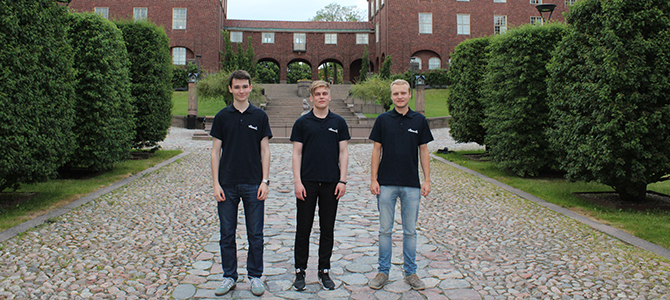To Puerto Rico with a device that gains energy from WiFi and 3G signals
Oskar Björkqvist, Oskar Dahlberg and Gustaf Silver decided to take the advanced course in theoretical electrical engineering in spring 2015. That decision has lead to a final position in an international student competition. To do this, they designed a device that obtains energy from WiFi and 3G signals.

Oskar Björkqvist explains what happened when they talked with the doctoral student Christos Kolitsidas, who introduced them to the competition.
"We were studying an advanced course in theoretical electrical engineering last year and Christos was the leader of practical exercises on the course. There were mostly just the three of us on the course, so we had quite a personal relationship with Christos who was very encouraging and enthusiastic when we wanted to learn more about the subject."
After the course was over, Kolitsidas and the students stayed in contact and Kolitsidas introduced them to antenna design. When the autumn term started, he suggested that the students could go in for a competition that was part of a larger scientific conference, where the goal was to: "Design and build a device that can convert radio waves into direct current". The KTH students' idea was one out of six applications selected, and they have been given the opportunity of presenting the concept at the conference in Puerto Rico.
The students have developed a circuit that can obtain energy from WiFi and 3G signals. The whole system has a total of 16 antennas that are aimed in different directions for maximum coverage. The output then goes through rectifier circuits that convert alternating current (AC) into direct current (DC). AC is the same type of electrical power that comes from the grid to the sockets in our homes. It is then converted to DC, which powers our electrical devices.
"The technology in itself is nothing new, but it has attracted more attention in recent years due to the huge increase in radio waves being transmitted. This gave rise to the idea that we could run small circuits independently, and avoid the maintenance and need for environmentally hazardous batteries," says Björkqvist.
At what point in the process are you at the moment?
"Now it's time to actually build the system and write a report describing the results. The deadline is March and we'll be working hard till then. Things will then be fairly calm until the end of June, when we go to Fajardo in Puerto Rico to take part in the conference to report on our project - which we are looking forward to doing," says Björkqvist.
Alternating theoretical courses with practical work has been a welcome aspect for the students:
"Oskar, Gustaf and I have really enjoyed being involved in a rather large project. Studying to become an electrical engineer involves a lot of theoretical courses which sometimes, at least for me, feels like you miss the connection between theory and the real world of engineering," says Björkqvist.
The project has also meant that the students' interest has been awakened in an area which they hardly knew existed.
"I think that my general interest in electrical engineering has grown recently, at the same time as I have got to know more about microwave technology, which I had hardly heard of a couple of years ago."
Even though Kolitsidas had already started to do research on his own, he has been impressed by the determination of these students, their enthusiasm and level of knowledge in the new area.
"In my view, they are among the very best that I have been lucky enough to work with. They have a deep understanding of the subject and have managed to assimilate knowledge that is way outside the usual syllabus, despite KTH's high ranking. I feel very fortunate to have had the opportunity to work with them, says Kolitsidas, who works at the department for electrical engineering theory and design.
In 2015, KTH was ranked 16th best in the world in the field of electrical engineering and electronics. As well as Kolitsidas, two of the teachers in the department, Oscar Quevedo Teruel and Lars Jonsson, have supported and helped the students with their project. Oscar Quevedo Teruel is also director of the master's programme in electrophysics, which has inspired the project group.
Easy choice among the master's programmes
Since all the students are in their third year of graduate studies in electrical engineering, they are going to select their master's programme in the spring.
"All three of us are planning to apply for the master's programme in electrophysics in the autumn, which is directly related to our project. Although I can only really speak for myself, I think this project has been an important influence in that choice," says Björkqvist.
But before they start their master's studies, they will first travel to Fajardo in Puerto Rico to participate in the conference there and present their competition entry. The result from the competition will be presented in June 2016.